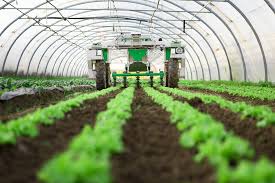Agriculture Notes On -Impacts Of The Green Revolution – For W.B.C.S. Examination.
The world production of cereals has increased about 2.53 times during 1961-2006 (FAO, 2007). During the same period, the cereal production in developing countries has increased 2.7 times, compared to 2.3 times in developed countries.Continue Reading Agriculture Notes On -Impacts Of The Green Revolution – For W.B.C.S. Examination.
The irrigated land area was 139 million ha in 1961, which increased to 210 million ha in 1980 and to 271 million ha in 2000. Worldwide fertilizer usage increased from 31 million tonnes in 1961 to 117 million tonnes in 1980 and to 137 million tonnes in 2000 (FAO, 2007). The world production of rice, wheat and corn during 1961-2000 also showed increasing trends (Fig. 1). Area planted under HYVs of wheat in 1978-79 was 72.4 percent of the total area under wheat in Asia, while 30.4 percent of the total area under rice was planted with HYVs (Table 1) (Dalrymple, 1978). In recent times, the second and third generation modern varieties (HYVs) have evolved and replaced the original modern varieties in many areas (Evenson and Gollin, 2003). In India, the total cereal production has increased from 70 million tonnes in 1961 to 186 million tonnes during 1961-1999, while in China, an increase from 91 million tonnes to 390 million tonnes during the same period has been observed. The number of tractors in developing countries rose from 0.2 million in 1961 to 4.6 million in 1998 (FAO, 2000).
Criticism
Though the Green Revolution was successful in increasing the food production tremendously, it has faced criticism for starting an era of chemical farming. Some argue that the high input agriculture methodology triggered problems such as soil degradation, soil salinity, chemical pollution and differential socioeconomic impacts leading to instability (Davies, 2003; Evenson and Gollin, 2003). Another argument against the Green Revolution is that it has itself led to poverty.
Critics argue that only the big farmers could access the costly technology introduced in the developing countries while the smaller farmers suffered and their economic condition further deteriorated and this widened the economic gap (Strauss, 2000). The supporters of the Green Revolution argue against these criticisms by stating that the Green Revolution actually reduced the poverty and helped the poor more than the rich because it was also associated with reduction in food prices as the production increased (Lipton, 2007). In spite of all the criticisms, Green Revolution is still a huge step undertaken by mankind in the direction of getting rid of hunger and food scarcity.
Emergence of CGIAR
As the Green Revolution started by CIMMYT and IRRI became successful, the need to expand their areas of operation was felt. The operations were to include more countries and more crops which required more staff and experts to test varieties in different agro-climatic areas. As a result, the Rockefeller and Ford foundation, with support from the World Bank and the UN Food and Agriculture Organization, established the CGIAR (Consultative Group on International Agricultural Research) in 1971, an organization which coordinates agricultural research in developing countries worldwide with support from the World Bank and various Governments. At present, CGIAR has about 15 international agricultural research centers (Murphy, 2007; CGIAR, 2010).
It has been observed that the state of agriculture is different in recent times than it was during the Green Revolution periods. Many experts are of the view that a slowdown in the Green Revolution has occurred and the various factors involved are, increase in demand accompanied with a loss of pace in the supply and the rising costs of food grains. Secondly, the support for agricultural research is decreasing and the shift of research from public to private sector is being witnessed.
Hence, compared to the type of public research carried out by charitable organizations, which kindled the Green Revolution and helped the poor is losing its grounds and multinational companies are taking over (Runge and Runge, 2010). According to the FAO (2010), the share of agriculture in GDP decreased from 30 percent to 11 percent in south East Asia between 1965 and 2004.
Please subscribe here to get all future updates on this post/page/category/website


 Toll Free 1800 572 9282
Toll Free 1800 572 9282  mailus@wbcsmadeeasy.in
mailus@wbcsmadeeasy.in



















































































































